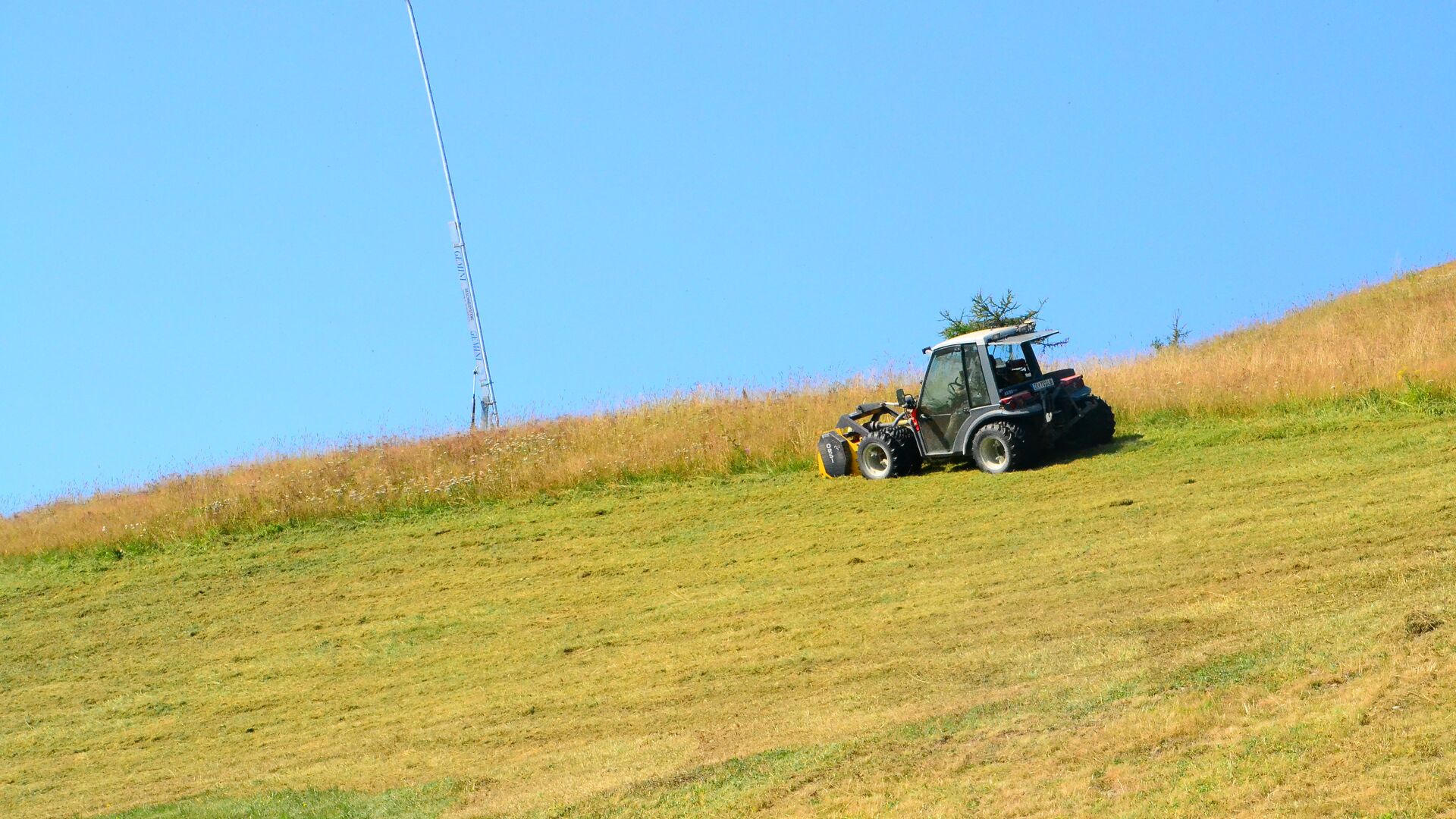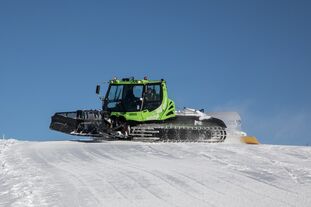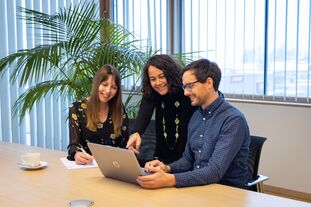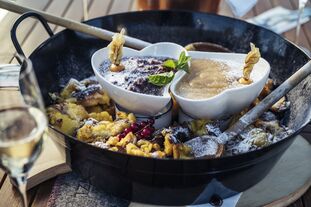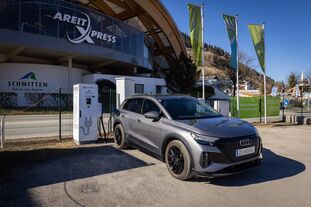FAQ on sustainability at the Schmittenhöhebahn AG
Questions and answers about the environmentally friendly activities of the cable car company
Since when has Schmittenhöhebahn AG been committed to sustainability? And: Do mountain sports and environmental protection really go together? We are answering these and other questions below.
Schmittenhöhebahn AG has already successfully implemented numerous measures to ensure winter sports enthusiasts can enjoy their time in the mountains in harmony with nature. In addition, activities and projects are constantly being developed and implemented to ensure the continued existence of the Schmitten’s natural biodiversity.
For instance, the slopes are actively managed in summer. The mowing time is set late so that insects have a protected habitat on the meadows for as long as possible. When mowing, the workers make sure to leave out the edges.
Winter sports enthusiasts can contribute to making skiing on the Schmittenhöhe more sustainable by doing the following:
- travel by public transport, which takes you directly to the slopes
- stop at restaurants and ski huts such as AreitAlm, which serve dishes made from regional ingredients
- avoid certain designated areas to protect the habitat of animals, thus ensuring a respectful coexistence
The water for snowmaking in winter comes from Lake Zell and the Salzach river. Thanks to percolation and evaporation, it can be used again and again. The use of energy-efficient snow grooming equipment and the optimisation of ski routes also contribute to the conservation of natural resources.
In order to raise awareness among winter sports enthusiasts and to protect the animals, the Schmittenhöhebahn is actively involved in the “Respektiere deine Grenzen” (“Know your limits”) initiative. The following measures are being implemented as part of the initiative:
- signposting of the retreat and refuge areas of native wild animals
- communication of the rules for dealing with the natural habitats and resources of the Schmitten on the website and via newsletter
Winter sports enthusiasts can also contribute to the achievement of the Schmitten’s sustainability goals – for instance, by switching to public transport, i.e. busses and trains. What’s more, there are numerous restaurants and other culinary establishments on the Schmitten where regional ingredients are used for cooking.
The Schmitten is located in Zell am See – Kaprun. The declared goal of the KEM region is to become the first CO2-neutral tourism destination in the Alps. In order to achieve this, measures are being implemented on an ongoing basis. These include, above all, the expansion of the public transport network.
The sustainability goals of the Schmittenhöhebahn AG are laid down in the environmental programme and continuously adapted. All projects to be implemented relate to the areas of ecology, waste, energy, gastronomy, further education and awareness-raising, information and emergency preparedness.
Tip: An overview of all goals for the current year can be found in the latest environmental report.
Whether it’s in the areas of energy and waste management, ecological piste and snow management or at culinary establishments and at the workplace: Schmittenhöhebahn AG is consistently committed to environmental protection.
Tip: Further measures that have already been successfully implemented by Schmittenhöhebahn AG can be found in the environmental report.
A particularly comfortable and relaxed way to get to the Schmitten is by train. Numerous direct connections from Hamburg, Münster and Vienna to Zell am See make a train journey particularly comfortable.
Locally, the range of city and ski buses is varied and demand-oriented. In winter, ski passes also serve as public transport tickets, so winter sports enthusiasts can save money and do something good for the environment at the same time.
Have you been travelling in your car including ski and snowboard equipment? Why not take advantage of the rental options on site and switch to travelling by train? Less stress – less baggage!
In the spirit of sustainable enjoyment of nature, numerous precautions have been taken by the Schmittenhöhebahn AG. There are waste separation systems at all valley stations of the feeder lifts as well as in well-visited areas on the mountain.
But hiking on the Schmitten is not the only environmentally friendly leisure activity. For a little more action, visitors of all ages can hop on the bikes at the E-Motocross Park and experience pure (and emission-free!) motorsports fun.
If you want to combine hiking with the enjoyment of sustainable culinary delights, the best thing to do is to go on the “Genussweg für Hüttenhocker” and stop at AreitAlm. Regional delicacies of alpine cuisine are waiting for you!
Boat tours on Lake Zell are not only impressive experiences but also predominantly sustainable activities. Since the summer of 2020, the ships have been fuelled with GTL fuel. The advantage of this is that much lower amounts of nitrogen oxide, sulphur oxide and particulate matter are released during combustion than with diesel. GTL thus contributes to the reduction of local emissions. Emissions that cannot be avoided are offset by the fuel supplier (Shell).
As early as 1988, the waste heat from the drive system was used to heat the premises of the Areitbahn I. This was an important step. Another milestone was the establishment of an environmental management system. The aim of this strategic measure: ensure a systematic approach to continuous improvement and optimised communication of environmental activities.
In 2011, an ecology advisory board was founded at the cable car company. It is made up of internal employees and external experts. Its tasks include identifying areas on the Schmitten that are worthy of protection, as well as setting measures for the management of these sensitive areas.
Significant events that followed:
2011
- Environmental audit of the status quo at Schmittenhöhebahn AG
2012
- Opening of the E-Motocross Park at Schmidolin’s Baptism of Fire to raise awareness of the topic of e-mobility among adventurers of all ages
- Test of the first biogas-powered snow groomer
2013
- Construction and commissioning of the first photovoltaic system on an area of 2,750 square metres (This is roughly the size of 10 tennis courts.)
2014
- EMAS (Eco Management Audit Scheme) certification by an external environmental auditor and entry in the EMAS register
- Since 2014, internal and external audits have regularly taken place.
2015
- Receipt of the EMAS certificate at the EMAS conference at Schönbrunn Palace in Vienna. The certificate was awarded by the then Minister of Agriculture, Forestry, Environment and Water Management.
- Implementation of numerous further training courses for employees, driver training courses and the training of an energy officer
- Commissioning of EV charging stations at the Areit car park
2016
- Opening of the “Kraut und Ruam” hiking trail with a focus on local herbs
- Start of the positioning of the Sonnkogel Restaurant as a restaurant with a focus on regionality and mountain herbs as well as the in-service training of Alfred Bürki as a TEH practitioner
- First test of a hybrid snow groomer
2017
- The first annual general meeting held as a “green event”
- Purchase of the first hybrid snow groomer
- Thermal refurbishment of the Schmittenhöhebahn mountain station for more resource-efficient operation
2018
- Start of the annual snow groomer driver training by a professional training academy
2019
- Implementation of a training course on water protection for captains at Lake Zell conducted by the division manager of navigation, who also holds the role of trained water protection supervisor
- Numerous studies conducted for ecological piste management
- Commissioning of a heat pump at the valley station of the zellamseeXpress
- Opening of the newly built residential units for employees of the Schmittenhöhebahn AG
2020
- Reduction of the fuel consumption of the piste equipment via the availability of additional refuelling stations or through route optimisation
- Implementation of several measures in the area of waste management such as the use of electronic waste bins and waste compactors
- Use of GTL fuel for the fleet of ships
2021
- Development of a summer management strategy for about 85 hectares of slope area with professional support from an engineering firm for landscape planning
- Examination of the use of GTL fuel for hybrid snow groomers
- The improvement of the routes led to the fact that the daily snow grooming activities could be carried out with 13 instead of 16 vehicles.
- Support for the “Wild & Kultiviert” (“Wild & Cultivated”) project of the province of Salzburg
2022
- Award of the Austrian Ecolabel to AreitAlm and AreitLounge as well as Sonnkogel Restaurant

